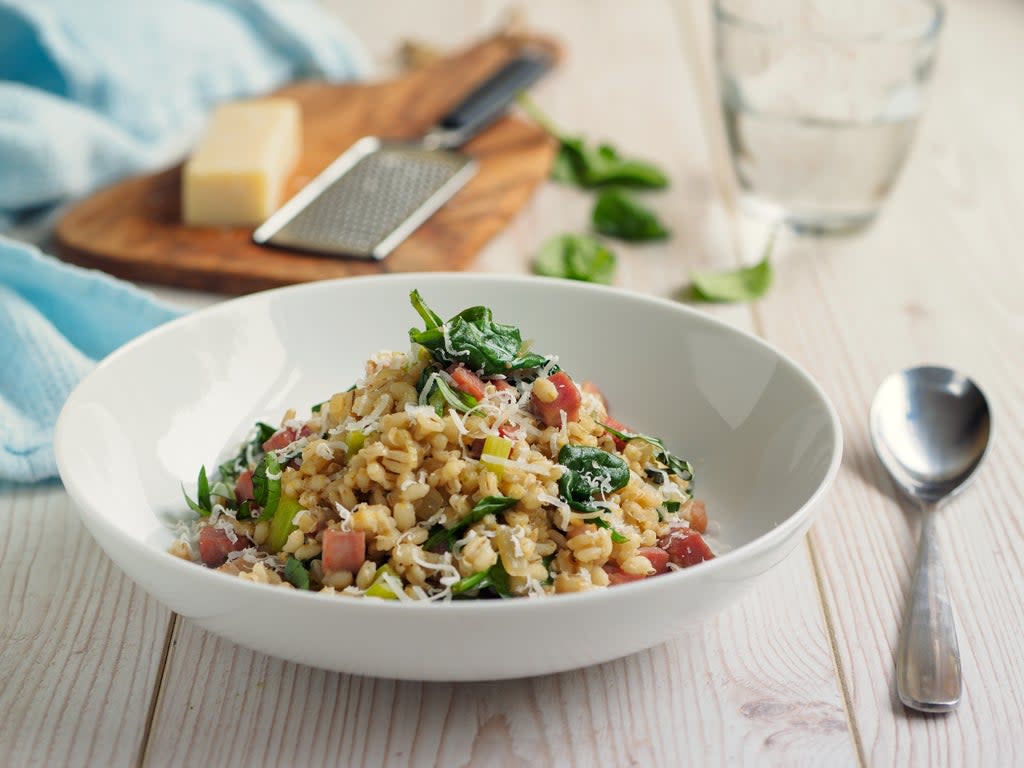Making risotto doesn’t have to be laborious – this recipe proves it

The day I found out that I didn’t have to stand over the risotto pot, stirring constantly with one hand as I awkwardly ladled in simmering liquid with the other, was the day the rice dish went into my permanent dinner rotation.
Before that, risotto was for special occasions only, something I’d trot out when I was trying to impress.
With the rumpled pages of my copy of Marcella Hazan’s Essentials of Classic Italian Cooking falling open to page 245 – risotto with parmesan cheese – I gave the cooking technique my full attention, heeding the formidable author’s precise instructions.
“You must never stop stirring,” she wrote, explaining that it is through “the gradual administration of small quantities of liquid” and never-ending stirring that the soft starch of the short-grain rice is able to bind with the broth, creating a satiny sauce.
Rice that is not constantly stirred, she admonished, “may turn into a perfectly agreeable dish, but it is not risotto, and will not taste like risotto.” (Emphasis hers.)
Dutifully, I stirred and stirred, losing hours of my life to those needy rice pots.
When I heard there was an entire contingent of risotto rebels who did not abide by constant stirring, I immediately joined their ranks.
An occasional vigorous stir, I learned, works perfectly well. So does cooking rice and broth together in a stovetop or electric pressure cooker. And so does baking it.
Whether you feel comfortable calling the dishes that result from these techniques risotto is up to you and the Marcella in your head. But they are excellent methods, undeniably easier, and I’ve never gone back to page 245.
For this vegetable-rich rendition, I add an entire bunch of chard, both stems and leaves, to the risotto pan. The stems, sliced and sautéed with some shallots, turn sweet and succulent. The chopped leaves are mixed in later, wilting in the broth and speckling the rice with bits of green. If you can get Swiss chard that’s red, it tints everything gorgeously pink, but Swiss or rainbow chard with stalks of any colour will work equally well.
I also threw in pancetta for a salty, brawny crunch. But it’s easy to leave out, and, if you weren’t expecting the pork, you’d never miss it. Or you can substitute shiitake or oyster mushrooms, sautéed until crisp.
The possibilities here really are endless. The ingredients in risotto, it turns out, are just as adaptable and forgiving as the cooking method.
Risotto with chard and pancetta
This satiny risotto uses an entire bunch of chard, both stems and leaves, which gives texture and colour to the tender grains of rice. Pancetta, crisped up in the pan, adds a savoury, brawny crunch that contrasts with the sweetness of the shallots or onion. Red chard turns the rice a subtle shade of pink, but Swiss or rainbow chard will work equally well. And don’t neglect that squeeze of fresh lemon juice right at the end; it brightens everything up.
Serves: 4-6
Total time: 50 minutes
Ingredients
110g pancetta or unsmoked bacon, diced
1 tbsp extra-virgin olive oil
2 tbsp unsalted butter
25g chopped shallots or red onion
1 (230g) bunch Swiss chard, preferably red Swiss chard, stems thinly sliced and leaves coarsely chopped
3 garlic cloves, finely grated or minced
300g Carnaroli, Vialone Nano or Arborio rice
1 tsp fine sea or table salt, plus more to taste
180ml cup dry white wine
1L chicken or vegetable broth, at room temperature (cold broth slows down the cooking)
1 tsp finely grated lemon zest (save lemon, cut into wedges, for serving)
30g grated parmesan, plus more for serving
Method
1. Combine pancetta and oil in a large frying pan and turn the heat to medium. Cook until fat has rendered and the pancetta is golden brown and crisp, stirring occasionally, 5 to 10 minutes. Use a slotted spoon to transfer pancetta to a paper towel-lined plate.
2. Add butter to the frying pan and let melt over medium heat. Stir in shallot and cook until translucent, 3 to 5 minutes. Add chard stems and garlic, and cook until fragrant and golden, 2 minutes.
3. Stir in rice and 1 teaspoon salt, and cook until rice is opaque and smells slightly toasted, 3 to 5 minutes.
4. Stir in wine and cook until it’s absorbed, about 3 minutes. Add stock, about 1/2 cup at a time, stirring occasionally, until the rice is cooked through but still has a slight bite, 20 to 27 minutes.
5. Add lemon zest and stir until well distributed. Stir in chard leaves and cook until softened, stirring occasionally, 5 minutes longer. If the risotto is too thick, stir in a little water or some more broth (do this until the level of creaminess pleases you; perfect risotto texture is subjective). Stir in parmesan, then taste and add more salt, if needed.
6. Spoon immediately into individual bowls. Sprinkle pancetta on top and finish with more parmesan and black pepper, if you’d like. Serve with lemon wedges on the side for squeezing.
And to drink …
I love chard. It finds a great middle ground between the firm, assertive texture of kale and the aggressive flavour of spinach. The blend of flavours in this dish calls for a white wine that is both crisp and incisive, but with some sense of volume that will match the richness of the rice and cheese. That means opting for better quality if you have a choice. A good Soave Classico would be excellent, as would a Gavi from the Piedmont region. A fiano from Campania would be delicious. Outside Italy, I would look at a grüner veltliner from the Wachau, a Sancerre and maybe a premier cru Chablis. If you want a red, try a Valpolicella Classico or a bottle from Corsica.
Pairings by Eric Asimov.
© The New York Times

